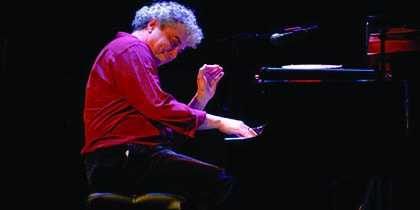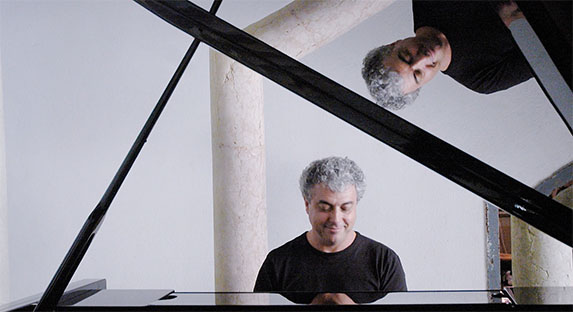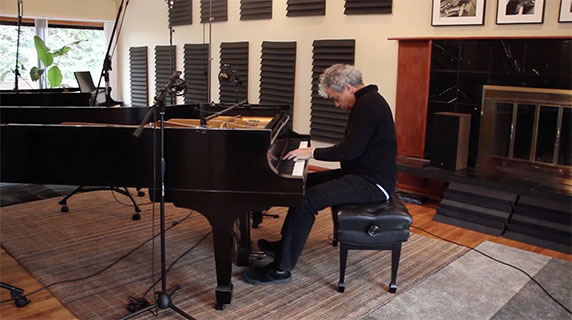
Jovino Santos Neto
Three-time Latin Grammy nominee Jovino Santos Neto, a master pianist, composer and arranger, is among the top Brazilian musicians working today.
Live Seminar Resources
Live Seminar Resources
PDF Downloads
- É Preciso Dizer Adeus - Chord Chart
Join PianoGroove Pro to access all downloads and learning resources.
Download theory supplements, midi files, chord changes and full note-for-note transcriptions of every lesson.
- Fotografia - Chord Chart
Join PianoGroove Pro to access all downloads and learning resources.
Download theory supplements, midi files, chord changes and full note-for-note transcriptions of every lesson.
Related Lessons
Forum Threads
Seminar Description
Seminar Description
Exploring "Fotografia" & "É Preciso Dizer Adeus" – Bossa Nova Classics
Welcome to this special lesson where we dive into two beautiful compositions by the legendary Antônio Carlos Jobim: "Fotografia" and "É Preciso Dizer Adeus". Both pieces capture the essence of bossa nova, with their rich harmonies, syncopated rhythms, and lyrical melodies.
Through this lesson, you’ll learn how to approach these tunes from a harmonic, rhythmic, and improvisational perspective, incorporating authentic bossa nova accompaniment techniques and expressive melodic phrasing.
"Fotografia" – A Romantic Bossa Nova Groove
"Fotografia" (which translates to "Photograph") is a laid-back, romantic bossa nova tune that paints a vivid picture of love by the ocean. The song stays within a C major tonality, utilizing pedal tones and chromatic movement to create Jobim’s signature harmonic richness.
Harmonic & Melodic Characteristics
- The song alternates between Cmaj7 and F7 (which can be thought of as C-7 over F).
- Chromatic passing tones add a smooth, flowing motion to the harmony.
- The melody starts on the 9th, a common Jobim characteristic that gives it a floating, airy feel.
- The 251 progression (D-7 to G7 to Cmaj7) is foundational to the harmonic movement.
Groove & Accompaniment
- The left hand follows a steady bossa nova bass pattern, alternating between root and fifths.
- The right-hand chords use spread voicings to provide a full, warm harmonic texture.
- Syncopation is key: avoid feeling the downbeat too heavily, as bossa nova has a natural push-pull feel.
Improvisation Tips
- Instead of running scales, focus on melodic motifs drawn from the tune itself.
- Emphasize chromatic approaches, mimicking Jobim’s style.
- Experiment with syncopation in your phrasing, ensuring your lines breathe within the groove.
"É Preciso Dizer Adeus" – A Song of Farewell
"É Preciso Dizer Adeus" ("It Is Necessary to Say Goodbye") is a slow, bittersweet bolero-influenced bossa nova, filled with lush harmonies and emotional depth. The lyrics speak of parting with love and gratitude, making it a deeply expressive piece.
Harmonic & Melodic Characteristics
- The opening Ab7b9 voicing sets a dramatic and colorful tone.
- The chromatic descent from F13 to F-7 highlights Jobim’s signature harmonic motion.
- The melody contains "bluesy" slides and expressive phrasing, reminiscent of samba-canção traditions.
Groove & Accompaniment
- The left hand uses a bolero-style bass line, alternating between downbeat hits and syncopated lifts.
- The right hand sustains melody notes over moving harmonies, creating an elegant, legato feel.
- Dynamics are crucial: keep the touch light and avoid over-accenting the groove.
Improvisation Tips
- Use the diminished scale to highlight the tension in passing chords.
- Explore arpeggiated voicings to create a flowing, harp-like effect.
- Keep phrasing melodic and song-like, rather than relying on rapid scalar runs.
Practice Tips
1. Master the Chord Inversions
- Practice Cmaj7 to F7 in all possible inversions to smoothen transitions.
2. Internalize the Rhythmic Feel
- Clap and vocalize the bossa nova pulse before playing.
- Avoid tapping your foot on every beat—feel the groove in two rather than four.
3. Focus on Chromaticism
- Pay attention to how chromatic movements shape the melody and harmony.
- Experiment with guide-tone lines (3rds and 7ths) moving stepwise.
4. Listen to Authentic Recordings
- Check out Miúcha & Tom Jobim’s recordings for phrasing and interpretation ideas.
5. Slow Down & Sing the Melody
- Before improvising, hum or sing the melody to absorb its natural phrasing.
Bringing It All Together
Both "Fotografia" and "É Preciso Dizer Adeus" showcase the depth of Jobim’s harmonic language and melodic beauty. By studying these pieces, you’ll develop a stronger rhythmic feel, a more lyrical approach to improvisation, and a richer harmonic vocabulary for playing and arranging bossa nova.
Take your time with these songs, focus on expressiveness over technical complexity, and most importantly—let the music breathe.
Happy practicing! 🎶







Jovino,
Thank you so much for this terrific lesson on two of my favorite pieces. There is so much of Jobim’s beautiful music to learn, so I would love it if you or Hayden would also have time to transcribe both pieces.
I am really looking forward to your seminar on Anos Dourados because I have been working on It as well. Could you play it in the key of CMaj? It would help reinforce what I am trying to learn from the other pieces. I have the sheet music in the key of F#m and with so many pieces that I want to learn, that key adds another dimension of difficulty and slows the learning process down considerably. Too much to learn, so little time! These lessons and watching you and Hayden play are pure joy.
Thank you again,
N
Lyrics
There’s no use to pretend
We have come to the end
All that’s left is to say goodbye
If I hold you with lies
It will show in my eyes
All that’s left is to say goodbye
So when you go I won’t stop you
But I will remember
How deep, how beautiful it was
And all this beauty of love that was our loss
And now leaves me sad
I don’t want to deny, don’t want to betray
Don’t want to forget
Because my love in my life
You have been like a day full of sun
So when you go I won’t stop you
But I will remember
How deep, how beautiful it was
And all this beauty of love that was our loss
And now leaves me sad
I don’t want to deny, don’t want to betray
Don’t want to forget
Because my love in my life
You have been like a day full of sun
Source: LyricFind
Songwriters: Antonio Carlos Jobim / Ray Gilbert
All That’s Left Is To Say Goodbye lyrics © Len Freedman Music Inc.
Astrud Gilberto – All That’s Left Is to Say Goodbye Lyricshttps://genius.com › Astrud-gilberto-all-thats-left-is-to-s…
Hi Noreen,
Thanks for the comments and I’m glad that you enjoyed the seminar.
Yes I can create a transcription of both pieces. I am currently working on the light up keyboard and in-lesson graphics.
I will reply to this comment when the transcription is ready.
Cheers,
Hayden
Great lesson Jovino. Would be great if we could get the blue keys for this one if possible? Many thanks!
Hi Richard,
This first half of this tutorial on the tune “Fotografia” is now available in regular lesson format here: pianogroove.com/bossa-nova-lessons/fotografia-tutorial/
We have added the light-up keyboard and also the notation with blue highlights.
This was edited some time ago and your comment reminded me that it needed to be added to the website.
Enjoy the lesson!
Cheers,
Hayden
Great- thanks very much Hayden.
Also, another suggestion for a Jobim song to cover which I don’t think Jovino has done before would be, “So Tinha de Ser Como Voce”. Thanks!
Thanks Richard – I will suggest this tune to Jovino for an upcoming seminar.
A question occured to me as I was watching Jovino’s lovely improvisation on Fotografia. What is the best way to use your improvisations for learning? Is it best to transcribe/learn them so we can see and understand exactly what you are playing?
Great question Richard.
I would recommend using Jovino’s solo as one of your sources of inspiration. It would certainly be a good idea to compile a list of recordings of this tune and make note of the specific parts of each solo that you like.
Transcribing from multiple sources will give you a wider pool of inspiration. Start to ‘mix and match’ some of the different components of each solo and you are then, in effect, improvising.
Exactly transcribing and emulating a solo can be a good exercise to understand the flow of a solo, and how to start and end your solos. However, try to not simply recite a full solo during your own performances, but rather incorporate improvisational elements and techniques that you have heard from a variety of sources.
Let me know if you have any other questions here.
Cheers,
Hayden
Thanks Hayden. That’s very helpful. I’m still at an early stage of building my repertoire of solos so yes, transcribing for a wider pool of inspiration sounds like a good way of looking at it.